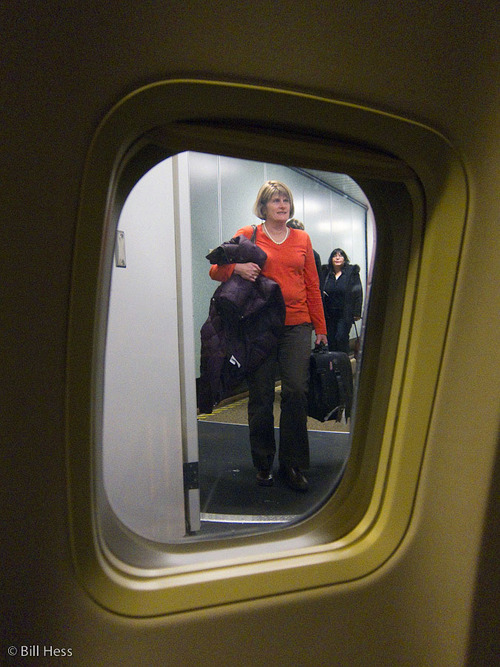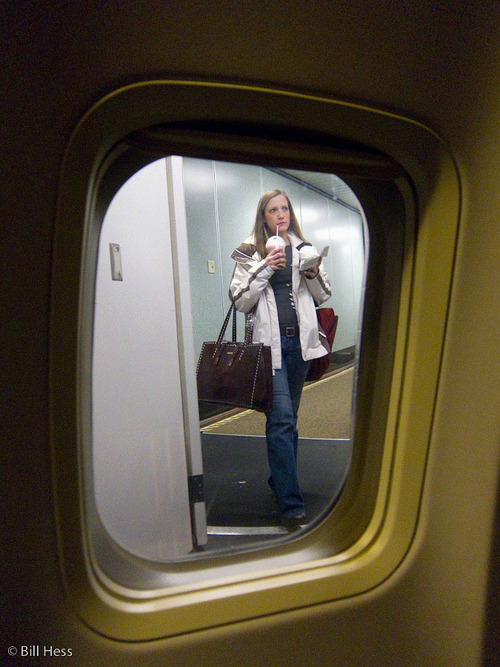Country and Rock guitarist Dr. Aaron Fox, who, with help from Chie Sakakibara, has returned Iñupiaq songs to the people of Barrow; Tagiugmiut and Suurimmaanitchuat, at Kivgiq
 Wednesday, April 14, 2010 at 3:40PM
Wednesday, April 14, 2010 at 3:40PM This is Dr. Aaron Fox, Associate Professor of Music, Chairman of the Department of Music at Columbia University and repatriator of Iñupiat song and dance to the people of Barrow, as seen through my iPhone. I met him for breakfast at the Hudson Diner - a place that he recommended both because it was right around the corner from where the Alaska House and Alice Rogoff had put me up, and because he said it was one of the few cafes left in the area that cater to the working class.
Shortly after we sat down, I saw the potential for a good picture of Aaron in the foreground as two adults accompanied by a young girl paused in the background outside the window. I framed it in my pocket camera and shot. The image that flashed up on my my LCD looked good, but I shot a second and third frame to give me a couple more options. As they flashed across the LCD, they, too, looked good.
Afterwards, I tried to pull them back up so that I could show them to Aaron - but instead of images, the camera gave me this stark message: "No Memory Card."
Yes - no memory card. I had already downloaded the pictures that I took earlier that morning for my Easter Sunday post and had forgotten to put the card back into the camera.
Once again, I had to turn to my iPhone.
So here is my portrait of Aaron Fox, shot with my iPhone.
Fox's title sounds pretty high-brow, but he is a country and rock guitarist and a former DJ. His favorite artists are are Stevie Ray Vaughan, Buddy Guy, John Lee Hooker, Aerosmith, Willie Nelson, and Merle Haggard.
He earned his PhD in Social Anthropology from University of Texas at Austin and an AB in Music from Harvard and holds a deep love for the traditional music of Native peoples worldwide. Columbia has a large collection of films and recordings of Native music.
The Columbia collection includes the work of Laura Boulton, who, from the 1920's through the 1970's, traveled the world to record the work of traditional and tribal peoples. She visited Barrow for one week in October of 1946 and recorded 120 drum-dance songs and oral narratives, performed by seven adult male performers and at least three children.
When Fox became the Director of the Center for Ethnomusicology in 2003, a position now held by his colleague Anna Maria Ochoa, he also became curator of the Boulton collection. By this time, the matter of who owned Native song and dance - the non-Natives who recorded them or the Natives who created and performed them - had become a public issue, and the understanding had grown that the ownership rights of Native people were as important to them as they are to any artists who create music.
While by law the publication rights to Boulton's recordings were held by Columbia, Fox launched a process both "to clarify the cultural ownership" of the works and to set up a process to repatriate the rights back to the people who had created them. Although he had been impressed with the Barrow recordings, he began this work with the Hopi and other Southwest tribes, thinking that sometime in the future he would turn his attention to the Barrow recordings.
Yet almost immediately, he was contacted by Dr. Chie Sakakibara, then a graduate student in Cultural Geography, who had begun a National Science Foundation project to do her doctoral research on the whaling cultures and climate change in Barrow and Point Hope.
Sakakibara had become aware of the Boulton recordings and wanted to learn more about them.
Aaron then asked Chie if she would help him locate living descendants of the singers Boulton had recorded. She eagerly agreed and set about to do so immediately. As she identified descendants and other interested Barrow Iñupiat, she sent their names and contact information to Aaron. He, in turn, sent CD's of the recordings to all who requested them.
Fox had anticipated that the process would be a slow one that would only develop into something sometime in the distant future, but as soon as the people of Barrow began to see the recordings, they took enthusiastic action themselves. Vernon Elavgak, a descendant of one of the seven drummers, his wife, Isabell, and Riley Sikvayugak, another descendent, organized a new dance group, the Tagiugmiut Dancers.
They listened to and learned the songs recorded in 1946 and began to practice motion dances put to those songs. The women designed beautiful, blue, outfits for their members, sewed them and then they began to perform in public, where they quickly proved popular. In 2007, Tagiugmiut won the Eskimo Dance category at the World Eskimon-Indian Olympics in Fairbanks and were invited to perform at the 2008 Gathering of Nations inter-tribal pow-wow in Albuquerque, New Mexico.
Fox and Sakakibara traveled together to Barrow and did many extensive interviews with descendants and other Iñupiat who love dance. They gathered information not only on the performances that had been filmed, but also on a collection of photographs gathered at the time by Boulton, photos which now belong to the Indiana University Archive of Traditional Music. Many of the photos are believe to have been taken by Marvin Peter, a noted Iñupiaq photographer of that time.
Aaron showed me a few of the photos on his phone, including the above image of Alfred Koonaloak, one of the seven singers.
As interested as the people were in the recordings of the drummers, Fox found that they were even more captivated by the photos of their relatives and fellow Iñupiat, most of them gone now. Sometimes, a viewer would gaze upon and study a single image for close to an hour at a time.
Among the most popular was this image of eight women and a child, gathered outside Barrow's Utqiagvik Presbyterian church house.
Aaron shows me a photo taken by Chie in which Mary Ahkivgak, daughter of Otis Ahkivgak, one of the 1946 singers, intently studies one of the photos from the Indiana University collection.
In another incident documented by Chie, the late Martha Aiken, a highly respected Barrow Elder, found a picture of her husband, who had already preceded her in death. She looked lovingly and longingly at the picture and then, through spoke softly through her tears. "That's my Robert," she said.
You can find the picture of Robert Aiken and the one Chie took of Martha viewing it right here.
So a partnership has now developed and is growing between the Iñupiat of Barrow and Columbia's Center for Ethnomusicology. The process of repatriation of ownership to be administer by the Iñupiat through The Iñupiat Heritage Center. While all rights will be held by the tribe, Columbia and the Heritage Center are working on an agreement that would license back usage rights for scholarly and teaching purposes, to be done in respectful ways.
Above is an image of the Tagiugmiut Dancers, that I took at Kivgiq 2009, as they performed a motion dance to a repatriated song.
Tagiugmiut. The woman at front center with the big smile is Isabell Elavgak, who helped her husband Vernon and Riley Sikvayugak to organize Tagiugmiut.
And that's Vernon on the left, during an invitational fun dance. The young man dancing alongside him is Ernest Nageak, son of Roy and Flossie Nageak, who has adopted into their family, as well as Chie as has another Barrow family, that of Jeslie and Julia Kaleak.
Jeslie and Julia have been active participants in the repatriation effort.
Tagiugmiut youth, performing a whale hunting dance at Kivgiq.
Aaron Fox in a fun dance with Tagiuqmiut after they invited him onto the floor.
Aaron is hugged by Josiah Patkotak of Barrow's Suurimmaanitchuat Eskimo Dance Group.
Barrow Elder Warren Matumeak in the midst of Suurimmaanitchuat. Matumeak has taken a strong interest in the project and has provided much information. At this moment, he is undergoing cancer treatment in Anchorage.
Suurimmaanitchuat - that's Mariah Ana Ahgeak-Fotukava and Maaku Matavale, beneath the drums.
On July 12 of last summer, Roy and Flossie Nageak, who have adopted Aaron into the their family and Pk-13 whaling crew as well as Chie, invited me to a 45th birthday dinner that they threw for him at their home in Barrow. I went, ate, and took photographs. I had planned to publish one of those photos in this article, but I must have inadvertently erased them from my card before I downloaded, because when I went to my folder dated July 12, all I found was three photos of the Alaskan husky, Dawson.
Fortunately, Bobby Akpik was there taking pictures as well. This one, of Aaron with Chie and the cake that she spent hours making for him, is posted on Sakakibara's Facebook page.
As can happen in small towns, when people saw Chie and Aaron going about the community together as they did their research, some speculated that perhaps they were a couple. Chie set the record straight on Facebook, as you can read in the photo.

























































